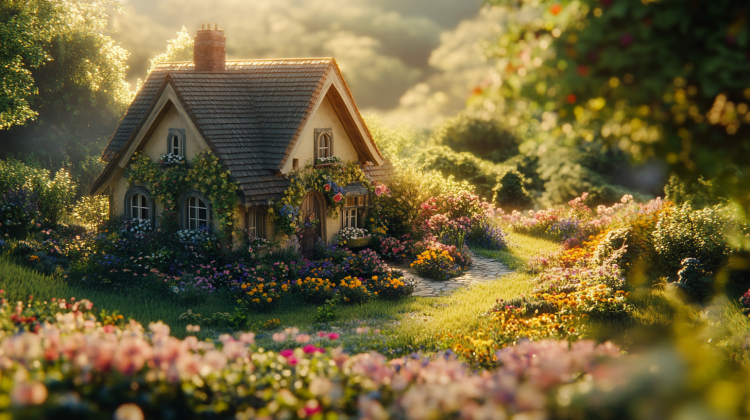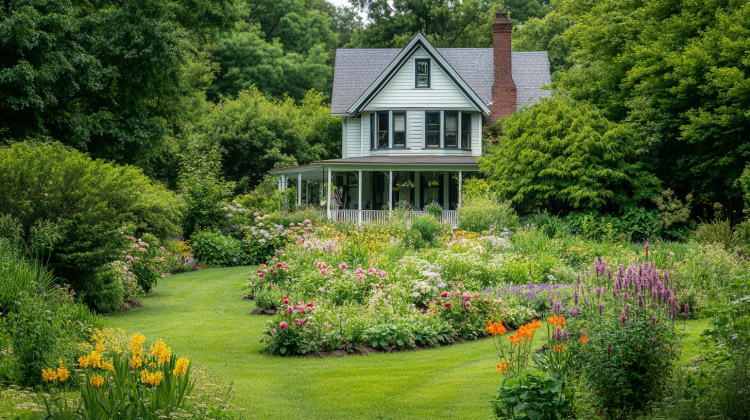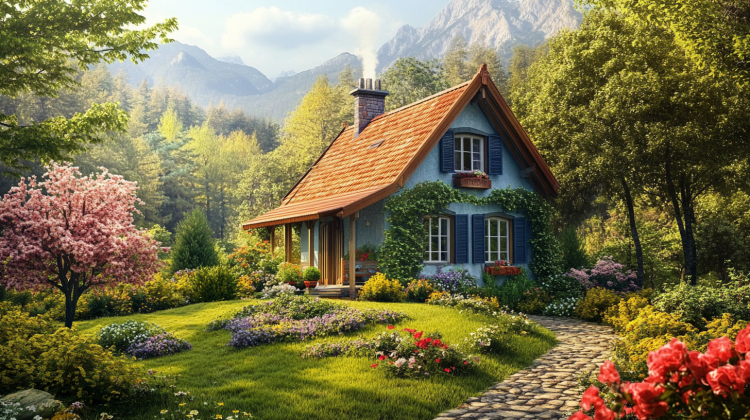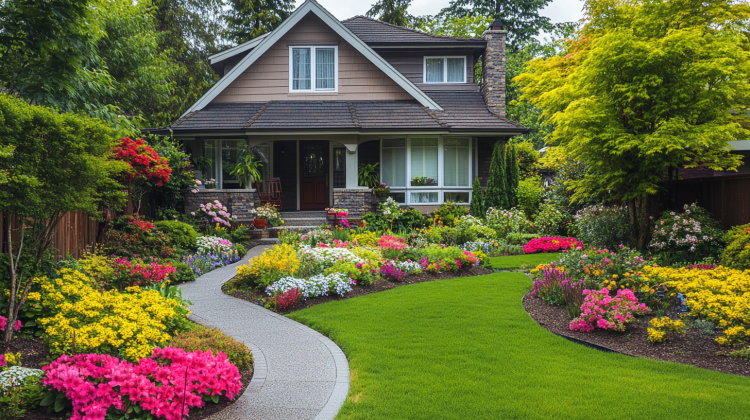
Gardening trends are evolving, and one of the most exciting movements in 2025 is the rise of the Modern Meadow—a naturalistic approach to landscaping that prioritizes biodiversity, pollinator-friendly plants, and a lush, effortless aesthetic. Whether you have a small backyard or acres of open space, this trend allows you to create a thriving, eco-friendly garden with minimal maintenance.
What Is a Modern Meadow Garden?
A Modern Meadow is a garden design concept that mimics the appearance and function of natural meadows. Unlike traditional manicured lawns or formal flower beds, a modern meadow embraces:
- Native and pollinator-friendly plants that attract bees, butterflies, and birds.
- A relaxed, flowing structure with an organic mix of perennials, wildflowers, and grasses.
- Low-maintenance design that requires little watering, fertilizing, or mowing.
- A dynamic and ever-changing appearance as plants bloom, seed, and regenerate throughout the seasons.
This trend blends the beauty of wild, open spaces with intentional design, making it an excellent choice for gardeners who want a sustainable and visually captivating outdoor space.
Benefits of a Modern Meadow Garden
The popularity of Modern Meadow gardens is driven by their numerous benefits:
1. Eco-Friendly and Sustainable
Modern meadows reduce reliance on pesticides, fertilizers, and excessive watering, making them a great option for sustainable gardening. Since many of the plants used are native, they thrive naturally in their environment with little human intervention.
2. Attracts Pollinators and Wildlife
A diverse selection of wildflowers and native plants provides essential food and shelter for bees, butterflies, and birds. This makes your garden a haven for wildlife while supporting biodiversity.
3. Low Maintenance
Unlike traditional gardens that require constant weeding, trimming, and watering, a modern meadow needs minimal upkeep once established. Occasional mowing or cutting back in late fall or early spring is usually enough to keep it healthy.
4. Year-Round Interest
Modern meadows are constantly evolving, offering different textures, colors, and blooms throughout the seasons. Even in winter, dried seed heads and ornamental grasses provide visual interest.
5. Eliminates the Need for a Traditional Lawn
Many homeowners are moving away from high-maintenance lawns in favor of meadow-style landscaping that is both functional and beautiful. Replacing traditional grass with wildflowers and ornamental grasses reduces water usage and creates a more dynamic outdoor space.
How to Create Your Own Modern Meadow
Ready to transform your outdoor space with a Modern Meadow garden? Here’s how to get started:
1. Choose the Right Location
Modern meadows thrive in open, sunny areas, though some plants can tolerate partial shade. The key is to find a spot that mimics natural meadow conditions.
2. Select Native and Pollinator-Friendly Plants
The foundation of a successful modern meadow is choosing the right mix of perennials, grasses, and wildflowers. Some excellent options include:
- Wildflowers: Black-eyed Susan, purple coneflower, coreopsis, yarrow, and milkweed.
- Ornamental Grasses: Little bluestem, switchgrass, feather reed grass, and fescue.
- Pollinator-Friendly Perennials: Bee balm, goldenrod, echinacea, and salvia.
Tip: Choose plants that are native to your region for the best results.
3. Prepare the Soil
While many meadow plants thrive in poor soil, some basic preparation helps ensure success:
- Remove existing turf or weeds.
- Loosen the soil and mix in a small amount of compost (if needed).
- Avoid heavy fertilization—meadow plants do best in lean, well-draining soil.
4. Plant and Seed
You can establish a modern meadow through seed planting, plug plants, or a combination of both.
- Seeding: Scatter a mix of native wildflower seeds and grass seeds for a natural look.
- Planting Plugs: For faster results, add young plants in small groupings to create structure and texture.
Water lightly until plants establish, then let nature take over.
5. Maintain with a Light Touch
One of the biggest perks of a Modern Meadow garden is its low-maintenance nature. However, some care is still necessary:
- Water during the first growing season, then reduce as plants become established.
- Mow or cut back in late winter or early spring to allow new growth.
- Leave seed heads and dried plants through the fall to provide food for birds and winter interest.

Modern Meadow vs. Traditional Garden: A Comparison
| Feature | Modern Meadow Garden | Traditional Garden |
|---|---|---|
| Maintenance Level | Low | High |
| Water Requirements | Minimal | High |
| Pollinator Support | Excellent | Varies |
| Seasonal Interest | Year-Round | Limited |
| Eco-Friendliness | High | Moderate |
Got it! Here’s an additional section to enhance your article without overwhelming it:
Incorporating a Modern Meadow in Small Spaces
You don’t need acres of land to embrace the Modern Meadow trend. Even small gardens, patios, or urban spaces can incorporate meadow-inspired elements. Here’s how to scale it down:
- Container Meadows: Use large planters or raised beds filled with wildflowers and grasses to create a mini-meadow effect.
- Border Plantings: Swap traditional garden borders for clusters of native flowers and ornamental grasses.
- Pollinator Patches: Even a small section of your yard can be dedicated to meadow plants, providing habitat for bees and butterflies.
- Meadow Strips: Replace strips of lawn along walkways or fences with drought-tolerant meadow plants for a low-maintenance yet vibrant display.
By applying meadow-inspired principles on a smaller scale, anyone can enjoy the beauty and benefits of this trend—no matter the size of their outdoor space.

Your Modern Meadow: Seasonal Care, Aesthetics, and Common Mistakes
Creating a Modern Meadow garden is more than just planting a few wildflowers and grasses. It’s a living, evolving ecosystem that changes throughout the seasons. To keep your meadow looking vibrant and healthy, it’s essential to understand seasonal care, design techniques, and how to avoid common pitfalls.
Seasonal Care for a Thriving Meadow
A well-planned Modern Meadow offers year-round interest, but it requires different approaches for each season. Here’s how to keep your meadow lush and thriving all year long.
Spring: Planting and Early Growth
Spring is the ideal time to plant new meadow seeds or young plants. If you are starting from scratch or adding new varieties, follow these steps:
- Direct Sow Wildflowers & Grasses: Scatter seeds of perennials and annuals directly onto the soil. Rake lightly to ensure good soil contact.
- Thin Out Dense Areas: If certain plants are crowding each other, thin them out to maintain airflow and prevent disease.
- Early Weeding: While a meadow is meant to look wild, aggressive weeds like bindweed or thistle can take over and should be pulled early.
- Watering: If spring is dry, give seedlings light but frequent watering until established.
Summer: Peak Bloom and Wildlife Activity
By early summer, your meadow should be coming to life with color and movement. To keep it at its best:
- Deadhead Selectively: While some plants should be left to seed, deadheading certain flowers (like cosmos and coreopsis) can prolong blooming.
- Minimal Watering: Established meadows should not need much water, but monitor for extreme drought conditions.
- Support for Taller Plants: If some perennials or grasses are flopping over, consider adding discreet stakes or plant supports.
- Enjoy the Pollinators! Your garden will likely be buzzing with bees, butterflies, and birds, so avoid using pesticides or chemicals.
Fall: Seeding, Cutting Back, and Preparing for Winter
Fall is a key season for meadow care because many plants self-seed, ensuring even better blooms next year. Here’s what to do:
- Leave Seed Heads: Many meadow plants, such as coneflowers, black-eyed Susans, and grasses, provide essential food for birds and reseed naturally.
- Cut Back Some Areas: While a fully untamed look is beautiful, you may choose to cut back about a third of your meadow to create structured layers.
- Plant Spring-Blooming Wildflowers: If you want a head start on next year’s growth, fall is a great time to sow wildflower seeds that need cold stratification.
Winter: Let Nature Take Over
Winter is the easiest season for a Modern Meadow—simply let it rest. However, there are still some considerations:
- Resist the Urge to Cut Everything Back: Dead plant material protects the soil, shelters insects, and provides visual interest.
- Observe Your Meadow’s Structure: Take note of which plants stand strong and which flop over—this can help you make adjustments for next season.
- Plan for the Next Year: Research new plants to introduce, adjust planting densities, and consider adding a meadow-inspired path or seating area.
Aesthetic Enhancements: How to Make a Wild Meadow Look Intentional
One of the biggest misconceptions about Modern Meadows is that they have to be messy or unkempt. While they embrace a naturalistic style, there are many ways to enhance their beauty while maintaining a cohesive design.
1. Define Borders and Pathways
To create visual structure, consider framing your meadow with natural edging such as:
- Stone or brick borders around the meadow to define the space.
- Mulched or gravel pathways to create intentional walkways.
- Low-growing plants like thyme or sedum to create a soft transition zone.
2. Use Height Variation for a Layered Look
Instead of planting at random, consider designing your meadow with intentional height layers:
- Tallest Plants: Ornamental grasses, Joe Pye weed, and milkweed at the back.
- Mid-Height Flowers: Coneflowers, black-eyed Susans, and bee balm in the center.
- Low-Growing Plants: Creeping thyme, sedums, or clover at the front.
3. Add Hardscaping for Contrast
A Modern Meadow doesn’t have to be purely plants. You can create visual balance by integrating:
- Decorative boulders for a natural landscape feel.
- A rustic wooden bench or arbor for a charming focal point.
- Metal garden sculptures that complement the meadow’s wild beauty.

Common Mistakes to Avoid in a Modern Meadow Garden
While meadow gardening is low-maintenance, certain missteps can hinder its success. Here are some common mistakes to watch out for:
1. Choosing the Wrong Plants for Your Region
Many people buy pre-mixed wildflower seeds without checking if they suit their climate. Always choose native plants for your specific area to ensure survival and growth.
2. Overwatering or Over-Fertilizing
Unlike traditional flower gardens, meadows thrive in lean conditions. Adding too much water or fertilizer can cause:
- Weak, leggy plants.
- Excessive weed growth.
- Reduced biodiversity.
3. Not Allowing for Self-Seeding
One of the biggest advantages of a Modern Meadow is that it regenerates itself naturally. Cutting everything back too early can disrupt the natural reseeding process and reduce next season’s blooms.
4. Ignoring Weeds in the First Year
While established meadows can compete with weeds, young meadows need early intervention. Hand-pull aggressive invaders in the first season to give desired plants a strong start.
5. Expecting Instant Results
A true meadow garden takes time to mature. The first year may look sparse, but by the second and third year, it will become denser and more beautiful. Be patient and let nature take its course!
Bringing It All Together: Your Perfect Modern Meadow Garden
A Modern Meadow is more than just a gardening trend—it’s a sustainable, ever-changing landscape that brings joy, biodiversity, and natural beauty to any space. By understanding seasonal care, aesthetic enhancements, and avoiding common mistakes, you can create a meadow that thrives for years to come.
Whether you’re starting small with a pollinator patch or replacing an entire lawn, embracing this naturalistic gardening approach will reward you with a low-maintenance, vibrant, and eco-friendly outdoor space.
Start planning your Modern Meadow today and enjoy the beauty of a garden that works with nature, not against it!

Modern Meadow Gardening Trend
The Modern Meadow gardening trend is a perfect blend of natural beauty, sustainability, and practicality. Whether you’re looking to ditch the lawn, attract more pollinators, or create a vibrant, ever-changing landscape, this style of gardening offers something for everyone.
By embracing native plants, wildflowers, and grasses, you can design a low-maintenance, eco-friendly outdoor space that feels both intentional and naturally wild. Start your Modern Meadow garden today and enjoy a lush, biodiverse landscape for years to come!





